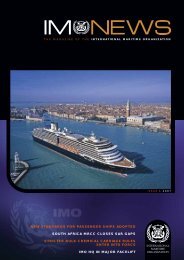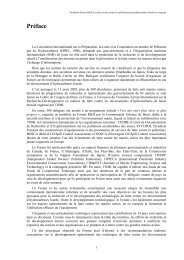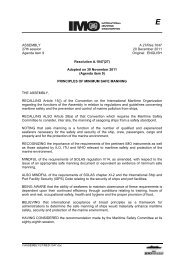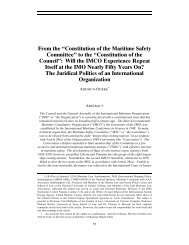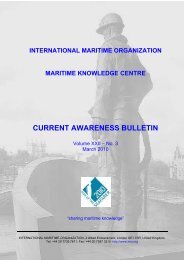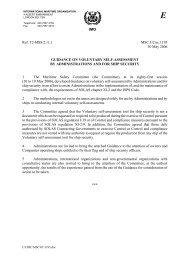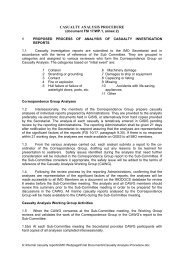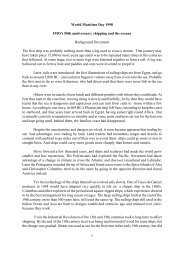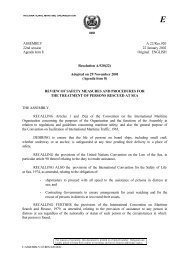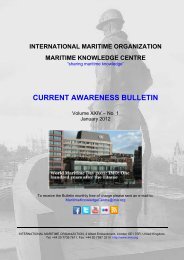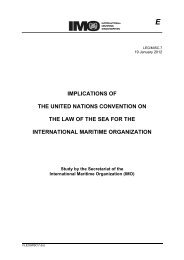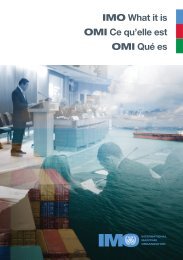Radioactive Waste Disposal at Sea: Public Ideas ... - IMO
Radioactive Waste Disposal at Sea: Public Ideas ... - IMO
Radioactive Waste Disposal at Sea: Public Ideas ... - IMO
You also want an ePaper? Increase the reach of your titles
YUMPU automatically turns print PDFs into web optimized ePapers that Google loves.
24 Chapter 2<br />
most important being radium (which decays to produce radon). Huge piles<br />
of tailings have accumul<strong>at</strong>ed <strong>at</strong> numerous sites. Typically, tailings are left<br />
near the uranium mills where the ore is processed. Today, regul<strong>at</strong>ors see the<br />
accumul<strong>at</strong>ion of huge piles of tailings as an unacceptable waste disposal<br />
practice. The best solution is to require burial of the tailings well below<br />
grade, or below the surface of the adjacent terrain. 11 So far, mill tailings<br />
have not been a subject of long and severe public protests.<br />
In the United St<strong>at</strong>es, low-level waste is defined by the Low Level<br />
<strong>Radioactive</strong> <strong>Waste</strong> Policy Act as radioactive waste not classified as highlevel<br />
radioactive waste, transuranic waste, spent nuclear fuel, or by-product<br />
m<strong>at</strong>erials as defined in Section 11e(2) of the Atomic Energy Act<br />
(uranium or thorium tailings and wastes). 12 It is, in other words, waste th<strong>at</strong><br />
does not fall into any of the other three c<strong>at</strong>egories. Low-level waste can take<br />
solid, liquid, or gaseous form. Typical waste includes contamin<strong>at</strong>ed protective<br />
shoe covers and clothing, wiping rags, mops, filters, reactor w<strong>at</strong>er<br />
tre<strong>at</strong>ment residues, equipment and tools, luminous dials, medical tubes,<br />
swabs, injection needles, syringes, and labor<strong>at</strong>ory animal carcasses and tissues<br />
(U.S. Nuclear Regul<strong>at</strong>ory Commission 1996, p. 11). Low-level<br />
radioactive waste is gener<strong>at</strong>ed by hospitals; by medical, educ<strong>at</strong>ional, or<br />
research institutions; in priv<strong>at</strong>e or government labor<strong>at</strong>ories; and <strong>at</strong> facilities<br />
forming part of the nuclear fuel cycle (e.g., nuclear power plants, fuel fabric<strong>at</strong>ion<br />
plants). The overall volume of low-level waste produced by commercial<br />
and government sources in the United St<strong>at</strong>es has increased steadily,<br />
especially since the l<strong>at</strong>e 1970s. Approxim<strong>at</strong>ely 4 million cubic meters of<br />
waste were produced in 1990, and the waste volume is expected to almost<br />
double by 2020 (U.S. Environmental Protection Agency 1994, p. 2). At the<br />
same time, as a result of the dram<strong>at</strong>ically rising costs of disposal, which<br />
have led to better packaging of the waste, the volume of disposed waste has<br />
decreased.<br />
Intern<strong>at</strong>ional Ocean <strong>Disposal</strong> before 1973<br />
Beginning as early as 1946 and extending into 1972, ocean disposal of lowlevel<br />
radioactive waste was practiced by a number of st<strong>at</strong>es without intern<strong>at</strong>ional<br />
controls. <strong>Disposal</strong> oper<strong>at</strong>ions were carried out under the direction<br />
of the relevant n<strong>at</strong>ional authorities. Gre<strong>at</strong> Britain was the principal dumping<br />
country between 1949 and 1970. Isol<strong>at</strong>ed instances of ocean disposal



